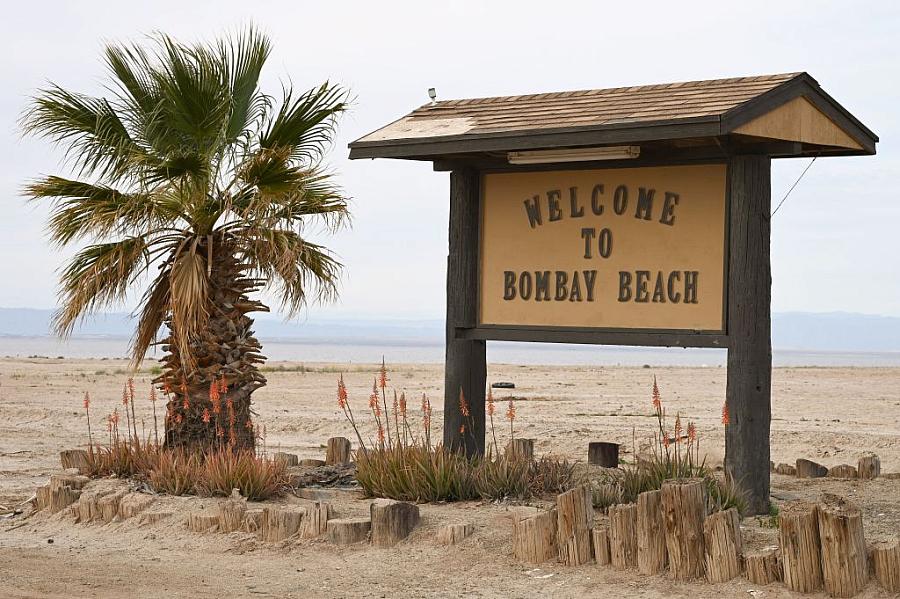California’s largest lake has become an epic environmental disaster

A sign advertises a once-thriving resort community along the shores of the Salton Sea.
(Photo by Robyn Beck/AFP via Getty Images)
It is astonishing how few Californians know about the existence of the Salton Sea. It is the state's largest lake and arguably, the state's worst environmental disaster.
My first encounter with the lake wasn't actually anywhere near it. I had just moved to the Coachella Valley, and one blistering 120-degree day, I woke up to the smell of rotten eggs in my backyard. It was nauseating. The entire valley was choked by the stench. And there was nothing we could do but wait for the winds to shift.
The smell, as I would find out, came from the Salton Sea, at the southern end of the Coachella Valley. It is a toxic lake with decades’ worth of decaying organic matter (like dead fish) at the bottom. When a storm or wind stirs up the rot, the sulfurous smell can waft over to the Coachella Valley. For residents, it's like sitting in a haze of burnt garbage fumes all day.
I wondered why the lake wasn't more like Lake Tahoe or Havasu — two breathtaking lakes known as vacation destinations with desirable waterfront property. This led to several questions: one, why was the lake so toxic? And two, what could be done to fix it?
The answers were incredibly complicated and required going back more than 100 years. The lake is shrinking, with dust from the exposed hazardous lakebed being kicked up and blown into the surrounding communities. Impoverished communities now live by the lake's shore, with little recourse as the lake's disastrous effects spread and affect the environment and health of residents in indelible ways.
I found that the majority of Coachella Valley residents had heard of the Salton Sea and knew it was "gross" but not much beyond that. They couldn't say why it was toxic, what the history was behind it, or who was in charge of revitalizing it.
This was the challenge we faced at the outset of our series on the Salton Sea, “Troubled Waters.” The project, supported by an Impact Fund grant from the Center for Health Journalism, started with deep research so we could understand the political history. Then we had to find out all the main players (and there were A LOT – more than 30 agencies and organizations were involved) and chase down the relevant people and agency heads to interview. After that, we had to distill incredibly complicated histories and water rights issues into something that a mainstream audience could easily understand – and be interested in.
No broadcast outlet has ever gone as deeply into the Salton Sea crisis as we have; we confronted major agencies and institutions, and we got them to admit things previously ignored or only hinted at — mainly, that they had failed in their responsibilities.
We also went into communities around the Salton Sea and shared their stories. Many residents do not speak English, which historically, has been a major factor in the failure to get government officials to listen to residents' testimonies and do something about the crisis. Stories are always, first and foremost, about people, and this series aimed to give voice to those who have been disenfranchised and dismissed for so long.
Our goal was to make a complicated issue easy to understand. We did that by establishing the history of the lake and then explaining how past actions have led to the current ecological and public health debacle. We dug through more than 1,000 pages of state audits, agency review reports, water rights contracts, and more from the past 20 years. One of the core questions we probed was this: for all the millions of dollars allocated to help the Salton Sea, why had there been no visible progress? What happened to the money and what was it spent on, if at all? We were able to finally answer that in our series.
Our coverage yielded immediate results. Rep. Raul Ruiz, a physician whose congressional district includes the Salton Sea, sent letters to the water agency and federal government, demanding accountability for a failed project highlighted in our story. He has also introduced the Salton Sea Projects Improvement Bill, speaking in front of a House subcommittee after our series aired. The Bureau of Reclamation has now allocated $1 million to another project our series had shown to be stalled. After our series, the state hosted a virtual roundtable on the Salton Sea — the first ever — and committed to an initiative that would yield more meaningful community engagement and dialogue.
We also received overwhelming viewer feedback, thanking us for explaining the problems in a palatable way. What really stood out to me were notes from lifelong Coachella Valley residents thanking us for helping them understand what was happening in their own backyard.

